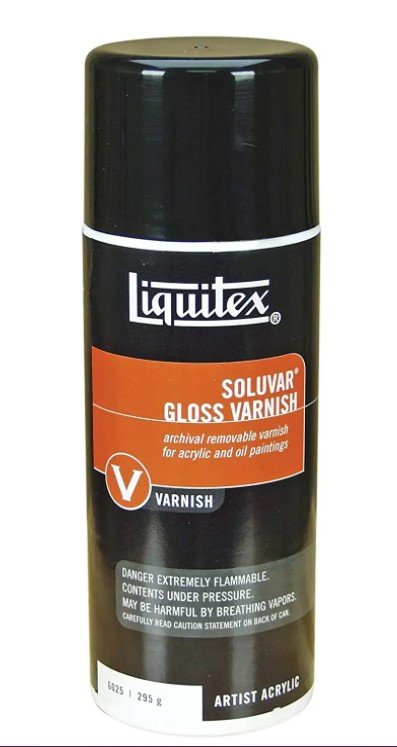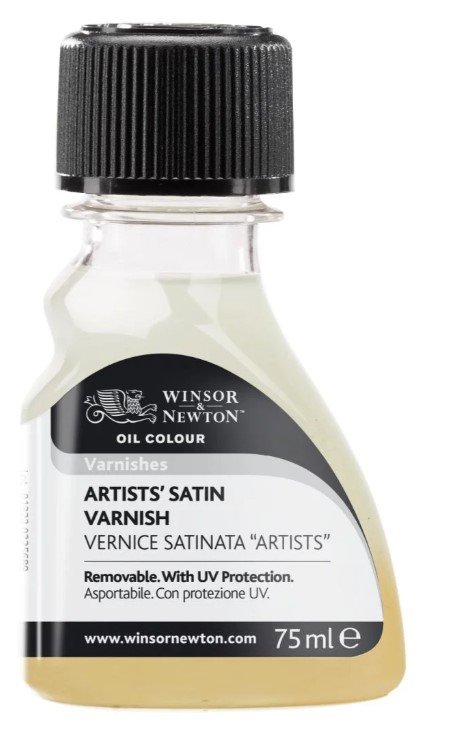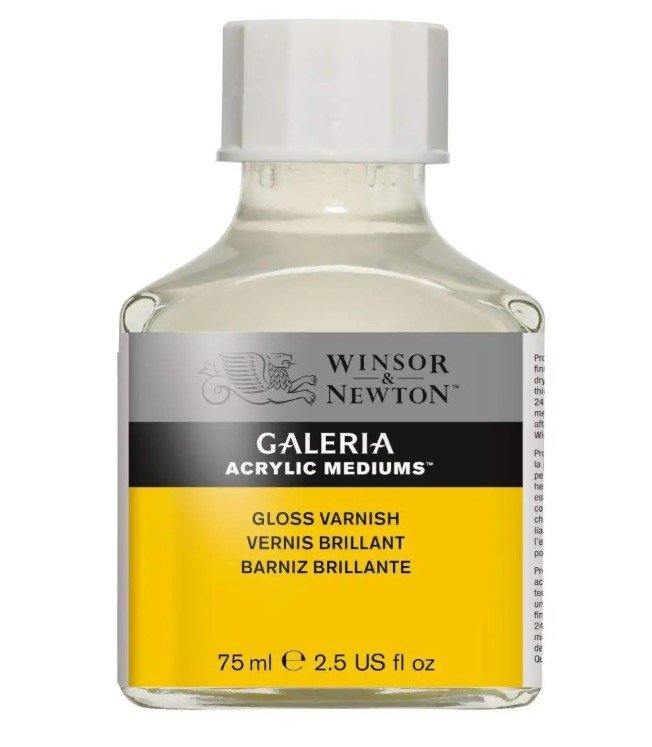In this article I will be talking about 7 best varnishes for acrylic and oil paintings and how to use it.
The word varnish in art world refers specifically to the liquid coatings used on oil paintings and other works of art intended for extended exposure to sunlight, rain, dust, heat, or cold (such as an interior painting).
These were traditionally made from linseed oil mixed with animal glue or resin.
Modern artists use different materials with different characteristics and effects.
Depending on one’s goals as an artist, there are many different choices of synthetic materials that can be used instead as opacifiers for acrylic paint: alkyd resins (including cresols),
acrylic resins, water-soluble urethanes (e.g., AcrylKlear™), methacrylate types (e.g., Polycrylic™), and plasticizers (e.g., Dilin 2™).
Choosing a varnish
Now that you know what type of paint to use and how the varnish will interact with your canvas, it’s time to choose a suitable varnish. Here are 7 best varnishes for acrylic and oil paintings and how to use it:
1. Golden – Polymer Varnish, Gloss
Golden Polymer Varnish is a water-based, high-gloss varnish that dries to a clear, permanent finish. It is an excellent choice for acrylic paintings and works well with all Golden Acrylic colors.

Golden Polymer Varnish can be used on canvas paintings or on any surface
that has been primed with acrylic gesso or spray primer before applying paint.
Spray it onto your canvas in thin coats so it doesn’t pool up in areas where you don’t want it to dry too quickly. Let each coat dry completely before applying another one.
This will help prevent buckling caused by not allowing enough time between
coats of paint drying between coats of varnish (which would otherwise cause warping).
2. Chroma/Liquitex Soluvar Professional Picture Varnish, Satin
Chroma/Liquitex Soluvar Professional Picture Varnish, Satin is a good choice for varnishing paintings.

It can be used on acrylics, oils and watercolors. This varnish protects your artwork from UV light while also protecting it from dust.
3. Chroma/Liquitex Soluvar Professional Picture Varnish, Gloss
If you’re looking for a gloss varnish for your canvas paintings, the Chroma/Liquitex Soluvar Professional Picture Varnish, Gloss is a good choice. This product is made by Chroma/Liquitex and has been specifically designed for use on acrylic paintings. It provides excellent coverage and can be used on canvas, wood or paper.

The consistency of this product is thick enough to penetrate into the pores of your canvas but still thin enough that it doesn’t leave behind any residue if applied over another layer of varnish (like gesso).
This makes it ideal for adding depth in between layers without causing too much excessive buildup around edges.
There’s nothing left but smooth surfaces where one layer meets another, which may cause problems later down the road once they’ve dried out completely!
4. Winsor & Newton Artisan Water Mixable Varnish, Satin
This Winsor & Newton Artisan Water Mixable Varnish, Satin is a great option for canvas paintings.
It can be used to tone down the brightness of the painting and reduce the amount of brushstrokes on your finished piece.
It also makes your canvas more durable by reducing water spotting and fading over time.

This varnish contains UV filters that help protect your artwork from harmful rays that could damage it over time.
The satin finish will give you a smooth surface while still allowing you to add texture with watercolor or pastels without disturbing its appearance too much (this means no blotching!).
5. Gamblin Galkyd Gel Mediums and Varnishes
Gamblin Galkyd Gel Mediums and Varnishes are a great choice for artists who work with acrylics. They are water-based, making them easy to clean up.
Gamblin Galkyd Gel Mediums have an odorless formula that makes it easier to work with than other mediums like spray paints or oil paints.
There is no need to worry about toxic fumes from these products either—they’re non-toxic and odorless!

These products can be used on wood panels as well as canvas paintings so if you’re looking for something versatile in your art studio then this might be just what you need!
6. Winsor & Newton Galeria Acrylic Fluid Medium and Varnishes
If you want to create a specific effect with your varnish,
Winsor & Newton Galeria Acrylic Fluid Medium and Varnishes are perfect. They can be used as a medium or a varnish, so they have many uses.
You can use them on canvas, paper and other surfaces that may be damaged by oil paints.
To make your painting look like it has been painted with watercolors but still retain some of the original texture of your canvas
(if you’re using acrylics), just mix both together in equal parts before applying it evenly across all areas of your work.

Winsor & Newton also offers other products such as Gel Mediums which allow you to use their gels instead of using
watercolors directly onto your surface—the result being that there will still be some visible marks left behind after drying out because they’re actually made from alcohol instead!
7. Golden Soft Gel (Gloss) & Polymer Varnishes
Golden Soft Gel (Gloss) & Polymer Varnishes is a high gloss, permanent varnish that provides a hard, durable finish on all surfaces.
It’s easy to apply and dries quickly so it can be used over and over again without damaging your canvas or damaging the artist’s original work of art.

How to varnish your painting
To apply the varnish, use a brush to apply it in multiple thin layers. Let each layer dry before applying the next one.
Varnish should be applied according to your painting’s size and shape, so you may need to shift the position of your painting on its surface if necessary.
Check out my video below, varnishing one of my acrylic canvas paintings:
Don’t apply too much varnish at once; this will create a glossy finish that is not flattering for acrylic paintings with lots of detail and color variation from light source (the sun).
There are so many great varnishes out there!
There are so many great varnishes out there! You don’t have to choose the most expensive or the cheapest. You can find a good one for your painting medium and budget.
The first thing to consider when choosing a varnish is compatibility with your painting medium.


The best way to do this is by looking at reviews from other artists who have used it in their own paintings, as well as reading customer reviews on sites like Amazon or eBay where people share their experiences with different products each day (so you don’t have to pay for shipping costs).
If possible, I would also ask someone at my local art supply store what kind of varnish they recommend using because they will know which ones work best with different types of canvas paintings depending on what type(s) we’re talking about here – watercolor paper vs oil paint surfaces.
Conclusion
The goal in choosing a varnish should not only be its stability at room temperature,
it should also protect the work from damage caused by
- humidity condensation
- dew formation due to light moisture on the surface of freshly painted surfaces before dry times are established
- drips of paint being removed from rolled surfaces during handling
- or transport without properly cleaning them first with solvent cleansers such as alcohol wipes or glycerol wipes;
- (i) direct light reflection caused by dripping water onto freshly painted surfaces before dry times are established;
- (ii) chemical reaction between the varnish itself and acids which can attack acrylic.
I hope this article has helped you to find your perfect varnish. If you have any questions or comments, please leave them below.




In your list above, you recommend (7) Golden Soft Gel (Gloss) & Polymer Varnishes.
I have a jar of Golden Soft Gel Gloss, and on the back label, it says, in all caps …
“DO NOT USE AS A TOPCOAT.”
So I’m guessing this probably isn’t the right varnish for your (acrylic) painting.
– Brent
Hi, what is the best finish for an acrylic painting with oil stick on canvas?
Thank you,
Adair
Thank you your comment! What do you mean by oil stick on canvas? Do you mean you have used oil paint before on the canvas?
Hi, my name is Mitchell, I basically paint with oils but in the past years I been using acrylics so I’m experimenting with finishings. I want to try something different. Epoxy only as a finish what would be the best approach.
First varnish I tried was Liquitex – satin. It is fantastically easy to use.
Brush on two coats one horizontal. Let dry, second application vertical. Smooth, even strokes in one direction, avoid running brush over after it is layed as it becomes tacky quickly and the varnish will act same way white school glue does by forming tiny clumps also this somehow breaks the shein and satin will be dull.
I apply vertical last because makes sense to me that when painting hangs if needs a light dusting. I will pull soft clothe or duster from top to bottom.
Thanks for your information.
I am curious l although chicken to try a different brand. I mean if it works, dont mess with the process.